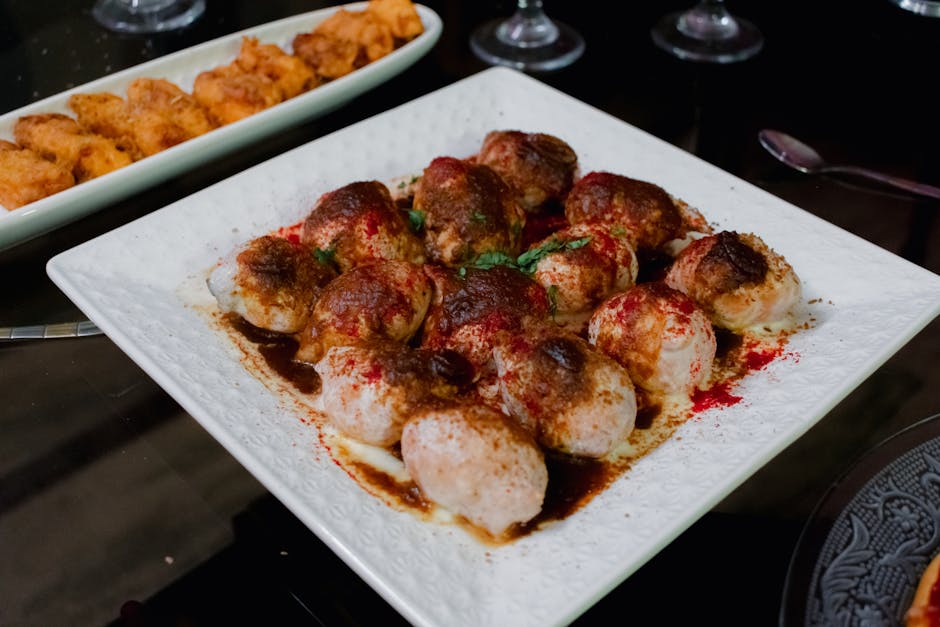
Dahi Vada, also known as Dahi Bhalla, is a beloved Indian street food and a festive favorite, especially during celebrations and festivals. These melt-in-your-mouth lentil fritters, soaked in creamy yogurt and topped with a medley of chutneys and spices, offer a delightful explosion of flavors and textures. This comprehensive guide will take you through every step of creating the perfect Dahi Vada, from preparing the lentil batter to assembling the final dish. Get ready to impress your family and friends with this culinary masterpiece!
The beauty of Dahi Vada lies in its simplicity and the contrasting elements it brings together. The soft, spongy vadas are a perfect canvas for the tangy yogurt, sweet tamarind chutney, and spicy green chutney. The dish is a symphony of flavors, textures, and aromas that will tantalize your taste buds and leave you craving more. This recipe aims to provide you with all the necessary information and tips to achieve the perfect Dahi Vada, ensuring a memorable dining experience.
Before we dive into the recipe, let’s appreciate the history and cultural significance of Dahi Vada. This dish has been a part of Indian cuisine for centuries, enjoyed across different regions with slight variations in ingredients and preparation. It’s more than just a food; it’s a symbol of celebration, community, and culinary artistry. The preparation process itself is often a shared experience, with family members contributing to different stages of the recipe. Making Dahi Vada is a testament to the enduring spirit of Indian cuisine.
Let’s get started on our journey to create the perfect Dahi Vada. We’ll cover everything from ingredient selection to the final presentation, ensuring you have all the tools and knowledge to succeed. This recipe is designed to be easy to follow, even for beginners, with detailed instructions and helpful tips to guide you along the way. We will focus on achieving the perfect texture and flavor, ensuring each bite of your Dahi Vada is a moment of pure enjoyment.
First, let’s take a look at the recipe overview:
| Category | Value |
|---|---|
| Preparation Time | 4-6 hours (including soaking time) |
| Cooking Time | 45-60 minutes |
| Servings | 6-8 servings |
| Difficulty | Medium |
Nutrition Information (per serving, approximate):
Calories: 350-400 kcal
Protein: 12-15g
Carbohydrates: 35-40g
Fat: 18-22g
Now, let’s move on to the ingredients you’ll need to make this delectable Dahi Vada:
Ingredients:
For the Vadas:
- 1 cup urad dal (split black gram), soaked in water for at least 4 hours or overnight
- 1/2 cup water (or as needed for grinding)
- 1 teaspoon ginger, grated
- 1-2 green chilies, finely chopped (adjust to taste)
- 1/4 teaspoon asafoetida (hing)
- Salt to taste
- Oil for deep frying
For Soaking the Vadas:
- Warm water
- A pinch of salt
For the Yogurt Mixture:
- 2 cups plain yogurt, whisked until smooth
- 1/2 cup water (or as needed to adjust consistency)
- Salt to taste
For Garnishing:
- Tamarind chutney
- Green chutney
- Roasted cumin powder
- Red chili powder
- Chopped coriander leaves
Having all the ingredients ready and measured will make the Dahi Vada preparation process smoother. Ensure the urad dal is properly soaked to achieve a fluffy and soft texture for the vadas.
Cooking Instructions
- Prepare the Urad Dal Paste: Drain the soaked urad dal and grind it into a smooth, fluffy paste. Use water sparingly during grinding to maintain the batter’s consistency. The batter should be light and airy.
- Add Spices and Seasonings: In a bowl, combine the urad dal paste with grated ginger, chopped green chilies, asafoetida, and salt. Mix well to incorporate the ingredients evenly.
- Heat the Oil: Heat oil in a deep frying pan or kadai over medium heat. The oil should be hot enough to fry the vadas without them absorbing excessive oil. Test the oil by dropping a tiny bit of batter into it; it should rise to the surface immediately.
- Fry the Vadas: Wet your hands with water to prevent the batter from sticking. Take a small portion of the batter and shape it into a round or slightly flattened disc. Gently slide the vada into the hot oil. Fry the vadas in batches, without overcrowding the pan.
- Fry Until Golden Brown: Fry the vadas until they turn golden brown on all sides. This usually takes about 5-7 minutes per batch. Remove the fried vadas from the oil and place them on a plate lined with absorbent paper to drain excess oil.
- Soak the Vadas: In a bowl, combine warm water and a pinch of salt. Gently submerge the fried vadas in this warm, salted water. Allow them to soak for about 20-30 minutes. This process helps to soften the vadas and make them spongy.
- Prepare the Yogurt Mixture: While the vadas are soaking, prepare the yogurt mixture. In a bowl, whisk the plain yogurt with water until it reaches a smooth, pourable consistency. Add salt to taste and mix well.
- Assemble the Dahi Vada: Gently squeeze out the excess water from the soaked vadas. Place the vadas in a serving bowl. Pour the prepared yogurt mixture over the vadas, ensuring they are fully submerged.
- Garnish and Serve: Garnish the Dahi Vada with tamarind chutney, green chutney, roasted cumin powder, red chili powder, and chopped coriander leaves. Serve immediately or chill for a few hours to allow the flavors to meld.
The cooking instructions are crucial to achieving the perfect Dahi Vada. Remember to maintain the oil temperature and avoid overcrowding the pan while frying the vadas. The soaking process is essential for achieving the soft, spongy texture that defines Dahi Vada.
Serving Suggestions:
- Serve Dahi Vada as a starter or a side dish.
- Garnish generously with chutneys and spices to enhance the flavor.
- Serve chilled for a refreshing experience, especially during hot weather.
- Pair Dahi Vada with other Indian snacks for a complete meal.
- Adjust the spice levels according to your preference.
Notes and Tips:
- Batter Consistency: The consistency of the urad dal batter is crucial. It should be thick enough to hold its shape when frying, but also light and airy to ensure fluffy vadas.
- Soaking the Dal: Soaking the urad dal for a sufficient amount of time (at least 4 hours) is essential for the vadas to be soft and fluffy. Soaking overnight is even better.
- Frying the Vadas: Fry the vadas on medium heat to ensure they cook evenly. Avoid frying them on high heat, as this can cause the outside to brown too quickly while the inside remains uncooked.
- Soaking the Vadas (Again): Soaking the fried vadas in warm, salted water helps them absorb the yogurt and become soft and spongy.
- Yogurt Consistency: Adjust the consistency of the yogurt mixture according to your preference. Some people prefer a thicker yogurt, while others prefer a thinner consistency.
- Chutney Variations: Experiment with different types of chutneys to add variety to the dish. Mint chutney, garlic chutney, or even a sweet mango chutney can be used.
- Make Ahead: You can prepare the vadas and the yogurt mixture in advance. Store the vadas in the refrigerator and assemble the Dahi Vada just before serving.
- Vegan Option: To make this recipe vegan, substitute the yogurt with a plant-based yogurt alternative like coconut yogurt or cashew yogurt.
- Spice Level: Adjust the amount of green chilies and red chili powder to control the spice level.
- Storage: Leftover Dahi Vada can be stored in the refrigerator for up to 2 days. However, the vadas may become soggy over time. It’s best to assemble the dish just before serving.
This comprehensive guide provides all the necessary information to create delicious Dahi Vada. From the urad dal batter preparation to the final garnishing, each step is explained in detail, ensuring you achieve the perfect results. Embrace the joy of making this classic Indian dish and share the experience with your loved ones. The process of making Dahi Vada is as rewarding as the final product itself, bringing a taste of Indian culinary tradition to your table. Enjoy your homemade Dahi Vada!
The versatility of Dahi Vada allows for numerous variations and customizations. You can adjust the spice levels, experiment with different chutneys, and even add other ingredients like pomegranate seeds or sev (crispy chickpea flour noodles) for added texture and flavor. The key is to strike a balance between the various elements, ensuring each bite is a delightful experience. The preparation of Dahi Vada is a testament to the rich culinary heritage of India, making it a perfect dish for any occasion.
Remember, the quality of the ingredients plays a significant role in the final outcome of your Dahi Vada. Use fresh, high-quality urad dal and yogurt for the best results. Freshly made chutneys will also enhance the flavor profile of the dish. The presentation of Dahi Vada is also important. Arrange the vadas neatly in a serving bowl and garnish them generously with chutneys and spices. A visually appealing dish is always more inviting and enjoyable.
Dahi Vada is more than just a dish; it’s an experience. It’s a celebration of flavors, textures, and aromas that come together in perfect harmony. By following this detailed guide, you can master the art of making Dahi Vada and create a culinary masterpiece that will impress everyone who tries it. Enjoy the process, experiment with different variations, and most importantly, have fun! The joy of cooking and sharing a delicious meal is what makes Dahi Vada so special. The soft, spongy texture of the vadas combined with the creamy yogurt and the burst of flavors from the chutneys create an unforgettable culinary experience. Making Dahi Vada is a rewarding culinary adventure that brings the essence of Indian cuisine to your kitchen.
The process of making Dahi Vada, from soaking the urad dal to the final garnishing, is a labor of love that reflects the rich traditions of Indian cuisine. The key to achieving the perfect Dahi Vada lies in the details: the quality of the ingredients, the consistency of the batter, the temperature of the oil, and the careful assembly of the dish. With patience and attention to detail, you can create a Dahi Vada that is soft, spongy, and bursting with flavor, a testament to your culinary skills and a delightful treat for anyone who tries it. So, gather your ingredients, put on your apron, and embark on this culinary journey to create the perfect Dahi Vada!
This detailed recipe is designed to help you master the art of making Dahi Vada. Remember that the process of making this dish is as enjoyable as eating it. Experiment, have fun, and most importantly, enjoy the deliciousness of your homemade Dahi Vada! Dahi Vada is a versatile dish that can be adapted to suit your taste preferences. Feel free to adjust the spice levels, the type of chutneys used, and the garnishes to create your own unique version of this classic Indian treat. The possibilities are endless, and the results are sure to be delicious.

